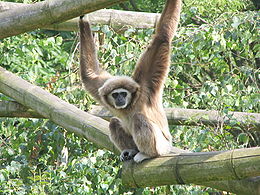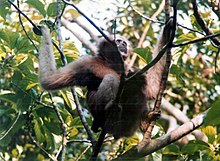 Gibbons are apes in the family Hylobatidae (pronounced /ˌhaɪlɵˈbeɪtɨdiː/). The family is divided into four genera based on their diploidchromosome number: Hylobates (44), Hoolock (38), Nomascus (52), and Symphalangus (50).[2][3] The extinct Bunopithecus sericus is a gibbon or gibbon-like ape which, until recently, was thought to be closely related to the hoolock gibbons.[2] Gibbons occur in tropical and subtropical rainforests from northeast India to Indonesia and north to southern China, including the islands of Sumatra, Borneo and Java.
Gibbons are apes in the family Hylobatidae (pronounced /ˌhaɪlɵˈbeɪtɨdiː/). The family is divided into four genera based on their diploidchromosome number: Hylobates (44), Hoolock (38), Nomascus (52), and Symphalangus (50).[2][3] The extinct Bunopithecus sericus is a gibbon or gibbon-like ape which, until recently, was thought to be closely related to the hoolock gibbons.[2] Gibbons occur in tropical and subtropical rainforests from northeast India to Indonesia and north to southern China, including the islands of Sumatra, Borneo and Java.Also called the lesser apes, gibbons differ from great apes (chimpanzees, bonobos, gorillas, orangutans and humans) in being smaller, exhibiting low sexual dimorphism, in not making nests, and in certain anatomical details in which they superficially more closely resemblemonkeys than great apes do. Gibbons also display pair-bonding, unlike most of the great apes. Gibbons are masters of their primary mode of locomotion, brachiation, swinging from branch to branch for distances of up to 15 m (50 ft), at speeds as high as 56 km/h (35 mph). They can also make leaps of up to 8 m (26 ft), and walk bipedally with their arms raised for balance. They are the fastest and most agile of all tree-dwelling, non-flying mammals.[4]
Depending on species and gender, gibbons' fur coloration varies from dark to light brown shades, and anywhere in between black and white. It is rare to see a completely white gibbon.
Anatomy
One unique aspect of gibbon physiology is that the wrist is composed of a ball and socket joint, allowing for biaxial movement. This greatly reduces the amount of energy needed in the upper arm and torso, while also reducing stress on the shoulder joint. Gibbons also have long hands and feet, with a deep cleft between the first and second digits of their hands. Their fur is usually black, gray, or brownish, often with white markings on hands, feet, and face. Some species have an enlarged throat sac, which inflates and serves as a resonating chamber when the animals call. This structure is enormous in a few species, equaling the size of the animal's head.
Gibbon skulls resemble those of great apes, with very short rostra, enlarged braincases, and large orbits that face forward. Gibbons have the typical nose of catarrhine primates with nostrils that are close together and face forward and slightly downward. They lack cheek pouches and their stomach is not sacculated. Their teeth also are similar to the great apes, with molars that are bunodont and lack lophs. The upper molars usually have a cingulum, which is sometimes large. The canines are prominent but not sexually dimorphic. The dental formula is: 

Behavior
Gibbons are social animals. They are strongly territorial, and defend their boundaries with vigorous visual and vocal displays. The vocal element, which can often be heard for distances of up to 1 km, consists of a duet between a mated pair, their young sometimes joining in. In most species males, and in some also females, sing solos that attract mates as well as advertise their territory.[5] The songs can make them an easy find for poachers who engage in the illegal wildlife trade and in sales of body parts for use in traditional medicine.
The gibbons' ball-and-socket joints allow them unmatched speed and accuracy when swinging through trees. Nonetheless, their mode of transportation can lead to hazards when a branch breaks or a hand slips, and researchers estimate that the majority of gibbons suffer bone fractures one or more times during their lifetimes.[4]
Status
Most species are threatened or endangered, most importantly from degradation or loss of their forest habitat. Gibbon species include the Siamang, the White-handed or Lar Gibbon, and the hoolock gibbons. The Siamang, which is the largest of the 13 species, is distinguished by having two fingers on each hand stuck together, hence the generic and species namesSymphalangus and syndactylus.
Classification
| Wikispecies has information related to: Hylobatidae |
- Family Hylobatidae: gibbons[1][3]
- Genus Hylobates
- Lar Gibbon or White-handed Gibbon, Hylobates lar
- Malaysian Lar Gibbon, Hylobates lar lar
- Carpenter's Lar Gibbon, Hylobates lar carpenteri
- Central Lar Gibbon, Hylobates lar entelloides
- Sumatran Lar Gibbon, Hylobates lar vestitus
- Yunnan Lar Gibbon, Hylobates lar yunnanensis
- Agile Gibbon or Black-handed Gibbon, Hylobates agilis
- Mountain Agile Gibbon, Hylobates agilis agilis
- Bornean White-bearded Gibbon, Hylobates agilis albibarbis
- Lowland Agile Gibbon, Hylobates agilis unko
- Müller's Bornean Gibbon, Hylobates muelleri
- Müller's Gray Gibbon, Hylobates muelleri muelleri
- Abbott's Gray Gibbon, Hylobates muelleri abbotti
- Northern Gray Gibbon, Hylobates muelleri funereus
- Silvery Gibbon, Hylobates moloch
- Western Silvery Gibbon or Western Javan Gibbon, Hylobates moloch moloch
- Eastern Silvery Gibbon or Central Javan Gibbon, Hylobates moloch pongoalsoni
- Pileated Gibbon or Capped Gibbon, Hylobates pileatus
- Kloss's Gibbon or Mentawai Gibbon or Bilou, Hylobates klossii
- Lar Gibbon or White-handed Gibbon, Hylobates lar
- Genus Hoolock
- Western Hoolock Gibbon, Hoolock hoolock
- Eastern Hoolock Gibbon, Hoolock leuconedys
- Genus Symphalangus
- Siamang, Symphalangus syndactylus
- Genus Nomascus
- Northern Buffed-cheeked Gibbon, Nomascus annamensis
- Concolor or Black Crested Gibbon, Nomascus concolor
- Nomascus concolor concolor
- Nomascus concolor lu
- Nomascus concolor jingdongensis
- Nomascus concolor furvogaster
- Eastern Black Crested Gibbon, Nomascus nasutus
- Cao Vit Black Crested Gibbon, Nomascus nasutus nasutus
- Hainan Black Crested Gibbon, Nomascus nasutus hainanus
- Northern White-cheeked Gibbon, Nomascus leucogenys
- Southern White-cheeked Gibbon, Nomascus siki
- Yellow-cheeked Gibbon, Nomascus gabriellae
Evolution
The dating of the evolution of these genera has been difficult.[6] The best current estimates place Nomascus diverging from the other genera at ~8 million years ago (Mya); Symphalangus and Hylobates diverging at 7 Mya. At the species level Hylobates pileatus diverged from Hylobates lar and Hylobates agilis at 3.9 Mya; and Hylobates lar and Hylobates agilis separated at 3.3 Mya.
Hybrids
Many gibbons are hard to identify based on fur coloration and are identified either by song or genetics.[7] These morphological ambiguities have led to hybrids in zoos. Zoos often receive gibbons of unknown origin and therefore rely on morphological variation or labels that are impossible to verify to assign species and subspecies names, so it is common for separate species of gibbons to be misidentified and housed together. Interspecific hybrids, hybrids within a genus, also occur in wild gibbons where the ranges overlap.[8]
In traditional Chinese culture
The Sinologist Robert van Gulik concluded that gibbons were widespread in Central and Southern China until at least the Song Dynasty, and furthermore, based on an analysis of references to primates in Chinese literature and their portrayal in Chinese paintings, that the Chinese word yuán (猿) referred specifically to gibbons until they were extirpated throughout most of the country due to habitat destruction (circa 14th century). In modern usage, however, yuán is a generic word for ape. Early Chinese writers viewed the "noble" gibbons, gracefully moving high in the treetops, as the "gentlemen" (jūnzǐ, 君子) of the forests, in contrast to the greedy macaques, attracted by human food. The Taoistsascribed occult properties to gibbons, believing them to be able to live a thousand years and to turn into humans.[9]
Gibbon figurines as old as from the 3-4th century BCE (the Zhou Dynasty) have been found in China. Later on, gibbons became a popular object for Chinese painters, especially during the Song Dynasty and early Yuan Dynasty, when Yì Yuánjí and Mùqī Fǎcháng excelled in painting these apes. From Chinese cultural influence, the Zen motif of the "gibbon grasping at the reflection of the moon in the water" became popular in Japanese art as well, even though gibbons have never occurred naturally in Japan.[10]





Tidak ada komentar:
Posting Komentar